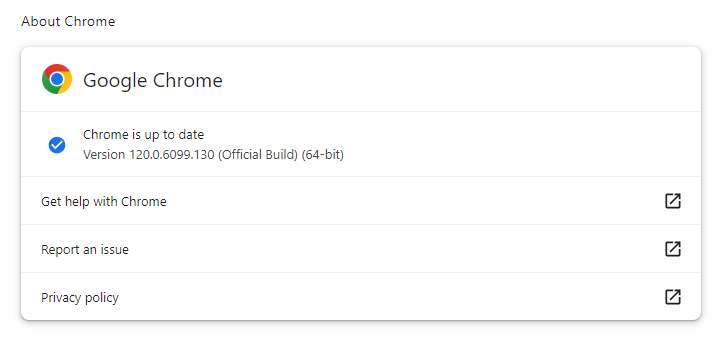[ad_1]
Google has released an emergency security update for Chrome that brings the browser’s Stable channel to version 120.0.6099.129 for Mac, Linux and to 120.0.6099.129/130 for Windows. This update includes one security fix for a vulnerability that was subject to an existing exploit.
The easiest way to update Chrome is to allow it to update automatically, which basically uses the same method as outlined below but does not require your attention. But you can end up lagging behind if you never close the browser or if something goes wrong—such as an extension stopping you from updating the browser.
So, it doesn’t hurt to check now and then. And now would be a good time, given the severity of the vulnerability in this patch. My preferred method is to have Chrome open the page chrome://settings/help which you can also find by clicking Settings > About Chrome.
If there is an update available, Chrome will notify you and start downloading it. Then all you have to do is relaunch the browser in order for the update to complete.

Google never gives out a lot of information about vulnerabilities, for obvious reasons. Access to bug details and links may be kept restricted until a majority of users are updated with a fix. However, from the update page we can learn a few things.
The Common Vulnerabilities and Exposures (CVE) database lists publicly disclosed computer security flaws. The zero-day patched in this update is listed as CVE-2023-7024, a heap buffer overflow in Web Real-Time Communications (WebRTC).
WebRTC on Chrome is the first true in-browser solution to real-time communications (RTC). It supports video, voice, and generic data to be sent between peers, allowing developers to build powerful voice- and video-communication solutions. The technology is available on all modern browsers as well as on native clients for all major platforms.
A WebRTC application will usually go through a common application flow. Access the media devices, open peer connections, discover peers, and start streaming.
A buffer overflow is a type of software vulnerability that exists when an area of memory within a software application reaches its address boundary and writes into an adjacent memory region. In software exploit code, two common areas that are targeted for overflows are the stack and the heap.
The heap is an area of memory made available for use by the program. The program can request blocks of memory for its use within the heap. When it uses memory blocks outside of the reserved area, this can influence other programs. This fact can be abused by an attacker.
The vulnerability was reported by members of Google’s Threat Analysis Group. This group frequently finds vulnerabilities that are used by state-sponsored groups in targeted attacks. This could indicate that Google found this vulnerability while researching an active attack, which matches the fact that an exploit for the vulnerability exists in the wild.
Since WebRTC is a Chromium component, users of other Chromium based browsers like Microsoft Edge will probably see a similar update.
We don’t just report on threats—we remove them
Cybersecurity risks should never spread beyond a headline. Keep threats off your devices by downloading Malwarebytes today.
[ad_2]
Source link
